Crossing the US border & Turning Yourself In, What Happens?
Two testimonies from Nicaraguans and a lawyer’s counsel
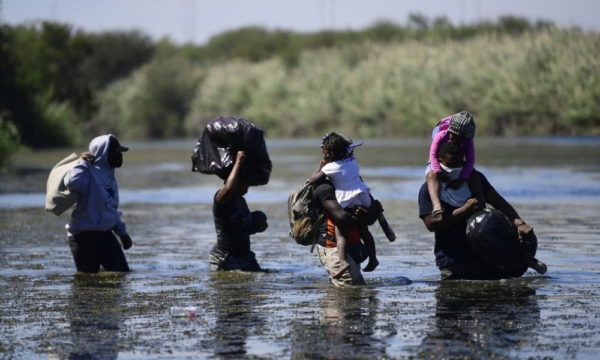
Two testimonies from Nicaraguans who crossed the Rio Grande into the US. An immigration lawyer explains the real options they have for remaining, and what happens after an immigrant crosses the border and turns themselves in.
HAVANA TIMES – Crossing three borders, plus the last, most dangerous one marked by the Rio Grande, is a challenge thousands of Nicaraguans have set out to face. Daily, “excursion buses” leave the country full of those seeking the “American Dream”. However, the story merely begins there, as these Nicaraguans begin juggling the rules that will guide their ability to remain, or not, in the United States.
Rosa [fictitious name] and Jonathan Aguirre are both 31-year-old Nicaraguans. They don’t know each other, but both crossed the Rio Grande in order to reach US territory and turn themselves in to immigration authorities. They both want to work in that country and improve their economic situation. Neither has a legal visa, and both hope to eventually go to US Immigration Court where a judge will rule on their future.
“Rosa” asked to remain anonymous, since she feared reprisals. She left Nicaragua on February 18, together with other Nicaraguans. She paid US $4,500 dollars to reach the US- Mexico border near Piedras Negras on March 3rd, just across the river from Eagle Pass, Texas. She explains that she couldn’t find work in Nicaragua and her husband emigrated to the United States in December. Together, they made the decision to leave their three children behind in Nicaragua.
Jonathan Aguirre is from Managua and says that emigrating to the United States has always been his dream. On March 11, he decided to make it a reality. Like Rosa, Aguirre paid US $4,500 dollars. That same day, he left on a bus, following the same route Rosa’s bus took: through Honduras, El Salvador and Guatemala, until reaching Mexico.
He says it was a quick trip without many problems, although he did have to spend 15 hours traveling from Tabasco to Mexico City in the luggage compartment of a bus. There wasn’t any light, and the four people sitting there couldn’t sleep, move, or resolve their physiological necessities. The slightest noise could cause them to be discovered.
Jonathan also mentions that when they reached the border at Piedras Negras, some Mexican police asked each member of the group for a bribe of US $100 to let them pass and board a bus. He asserted that the best thing to do is pay them, because if not, they’ll send you back.
Rosa recalls one difficult moment: “The last stop we made was in a house in Mexico. It was dirty, with garbage all over and there were some 150 people there, on top of each other, while the mice ran around,” she tells us.
Aguirre experienced a similar situation in a house in Mexico. “We reached a warehouse on the border [at Piedras Negras]. It was dirty, there were six Cubans there, and we all left on a vehicle that took us to the Rio Grande,” Aguirre told La Prensa via telephone.
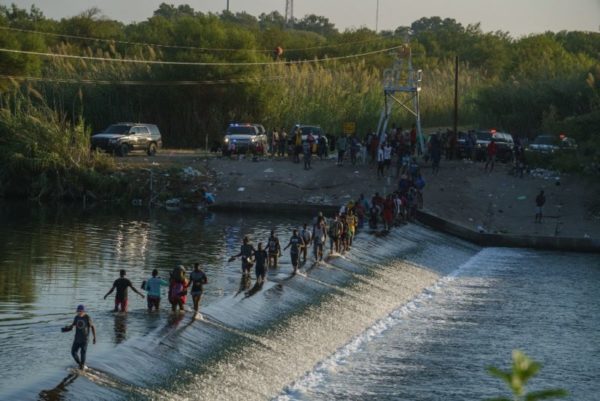
Jonathan crossed the Rio Grande at Piedras Negras on March 21, together with some Cuban migrants, who had a rope and knew how to swim. “That helped us, because we used the ropes they brought. When you get to the river, you have to just throw yourself in. They don’t give you time to think about where you’re going to dive in. But after walking in, after a meter the water’s already up to your chest and the current is strong. I can’t swim. Thanks to the Cubans I managed to cross,” Jonathan Aguirre states.
He feels that the “guides, as he refers to the coyotes, treated the Nicaraguans well, but in the case of the Cubans, “they treat them like dogs, and they pay three times what we pay. There are Cubans who pay up to US $20,000 to reach the border,” Aguirre relates.
For her part, Rosa together with other Nicaraguan and Cuban migrants, reached the border at Piedras Negras in the early morning of March 3. The coyote had assured her they’d cross the Rio Grande on a raft, but in the end, they had to swim across. “I got separated from the group; the river was dragging me off, but I succeeded at rejoining them. When we got across, US immigration agents were waiting,” she told us by telephone from the United States.
“A sea of clothes, shoes, everything people leave behind”
What happens after you cross the Rio Grande? What’s the procedure once the migrant turns themselves in to the [US.] authorities? What guarantees are there that a migrant will be allowed to remain in that country?
After reaching the other side of the Rio Grande, you come upon “a sea of clothes, shoes, everything people leave behind, because they get in your way and get muddy,” says Aguirre. Also waiting on the other side are US Immigration agents. “When I turned myself in, they gave me water and asked me if I was alright. They also asked my name and what country I was from. Later, they took us to a detention center,” he explains.
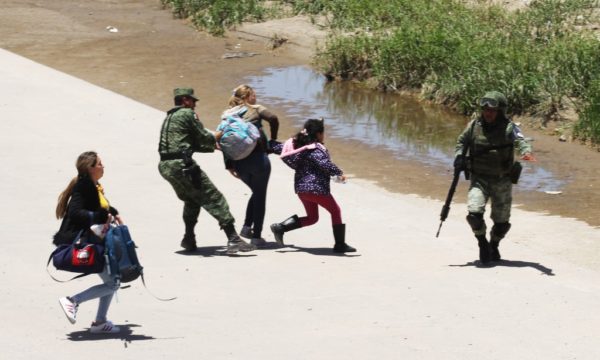
Rosa recalls that when her group was stopped by Immigration, they were asked to remain quiet. The agents ordered them to hand over any belongings that could cause harm, such as socks, shoelaces, or belts. They asked their names, and gave them a bag with these names on it, where they could put their cellphones, money and personal documents.
Upon turning herself in, Rosa told the US border agents that she was Nicaraguan and gave them her I.D. card. She also signed a document registering the day, hour and place of entry. They took her fingerprints.
When Jonathan Aguirre arrived at the detention center, he estimates there were some 1,500 others there. All the newly arriving migrants went through the same process. He passed from table to table, filling out personal information on his family, where he was going, if he had family in the United States. Also, before entering the center, you have to throw out all your clothes and personal belongings, except for money, documents and cellphones. Later, Aguirre says, they take pictures of you and register your fingerprints.
In Aguirre’s case, he spent only one day in the detention center. He was then taken to a shelter in a church in Paso de Aguila, Texas where they give the migrants food, clothing and a place to rest. Once in the shelter, Aguirre called his aunt who lives in the United States, so she could purchase his plane ticket to Kansas, Missouri.
In contrast, Rosa was taken to one of the sites popularly known as hieleras [“iceboxes”] right across the border from the Mexican town of Piedras Negras, just into US territory. She was given thermal blankets for the cold. “They put us in that place, we changed our clothes, and they took us to some rooms,” she recalls.
The hieleras are short-term detention centers that migrants describe as very cold. They’re run by US Customs and Border Protection, a federal agency. According to the US government rules, migrants can’t be held there over 72 hours.
The next morning, Immigration agents moved Rosa to a detention center in Laredo, Texas, where she spent a week. “When I was in Laredo, we didn’t know if it was day or night. We were locked up. They gave us potato chips, juice or burritos, and we slept on air mattresses. We were allowed a two-minute shower, every four days at 2 am. Upon entering the shower area, they inspect your whole body, and when you leave, they do it again to make sure you’re not taking the soap or toothpaste,” Rosa remembers.
When an immigration official arrived at the Laredo detention center, she was asked if she were fleeing political persecution or had a need to enter the United States. “I told them I had to enter the United States because I needed to work and my husband was in the US.” Rosa recalls that they also asked her about her parents, their ages, where they lived, and the information about her children and her husband.
After Laredo, they transferred Rosa to another detention center in Dilley, Texas, where she remained for 21 days. Afterwards, Immigration agents issued her a telephone, where she had to report every Wednesday and send a photo. “Immigration officials communicated with my husband and told him to buy my airplane ticket,” says Rosa. She’s currently residing in Wisconsin, together with other Nicaraguan immigrants.
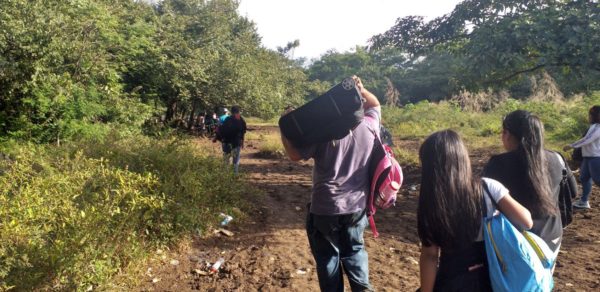
When Rosa was released from the center at Dilley, immigration officers took her to the San Antonio airport, where they checked her ticket and took pictures. “Immigration gave me a document, saying we can’t work legally. “I have a court date for April 2023,” Rosa states.
Jonathan Aguirre was released without an electronic tracking bracelet or a telephone for monitoring his movements. However, he was given a document assigning him to report to Court on May 24. He plans to assist with a pro bono lawyer.
The legal perspective: what guarantees does surrender to Immigration offer?
From that point on – What are the real options Nicaraguan migrants have for remaining in the US if their true motive is economic, that is, they’re not fleeing political persecution?
If a petition to remain in the US is denied by a court, what consequences will that have, since the immigration authorities already have all my information?
Astrid Montealegre, immigration specialist and supervisor of the Nicaraguan Human Rights Alliance, explained to La Prensa that once you’re found or surrender to Immigration Agents after crossing the border, there are three possible scenarios:
1. If the person reaches a port of entry into the United States with a completed asylum petition and their evidence translated into English, they will merely be processed and detained for a maximum period of a week for crossing the border illegally.
2. A person who has crossed the border irregularly [without an entry visa], but didn’t turn themselves in to Immigration and is later captured in US territory, will be subject to expedited deportation, or for detention while awaiting a deportation hearing, where they’ll need to fight for asylum.
3. If the person crosses without entry papers and turns themselves in, the consequences vary. It’s possible that they’ll be held for days or weeks. Or, they could be subject to the “wait in Mexico” policy, and be told to wait in that country until the date of their trial, which could be anywhere from two weeks up to three months or more.
The attorney does clarify that crossing the border and turning oneself in to Immigration doesn’t guarantee your permanence in the United States. Even when you’re allowed to travel on your own recognizance, you’ll have to appear before a judge and present your case to see if you qualify for asylum.
“In order to qualify for asylum, you must prove “credible fear”, based on your personal declaration and any other proof establishing that you’re suffering persecution and that it’s probable that you’ll continue to be persecuted based on your race, religion, political opinion, gender, religious group, or because you belong to a particular social group, like a journalist, human rights advocate, member of the clergy, or feminist,” she specified.
Not a good idea to allege economic problems
The specialist in immigration law explained that if a migrant reaches the US seeking to work and improve their economic situation, their case for asylum will not be approved, and they’ll be deported. The law doesn’t contemplate the need to work as a valid justification for immigration, without obtaining a work visa, the legal option for working in the United States.
“If you can prove that you could be subject to torture upon return, they can annul the deportation order, and the person may file a request for a work permit, but they won’t grant asylum and you’ll never be able to become a legal permanent resident,” Montealegre explained.
Another of the options for remaining in the United States, according to the attorney, is if the Nicaraguan immigrant has a family member that’s an American citizen and could suffer irreparable damage if the immigrant is deported. For example, if that citizen is an elderly person who depends on the care of their immigrant family member, or if the immigrant is married to a U.S. citizen who has a terminal illness, or an illness which leaves them completely dependent on the migrant. In such cases, the immigrant can request a judge’s pardon.
According to Attorney Astrid Montealegre, all the Nicaraguan who are in the United States awaiting their hearing and are working without permission will end up being deported. In addition, a judge can sanction them and forbid them from entering the country for ten years.
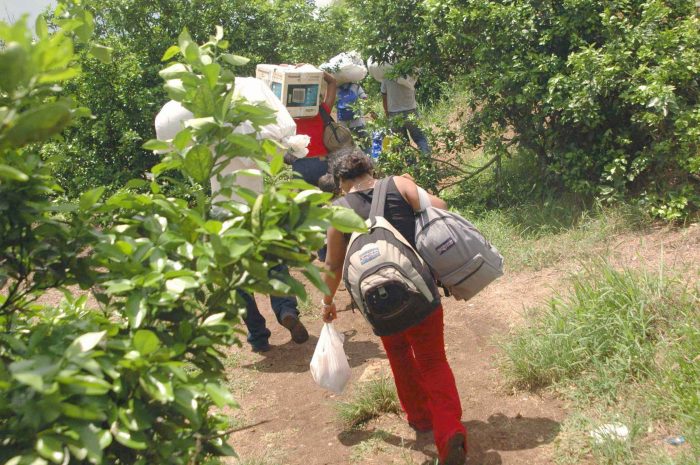
If the migrant was released on bond after being in a detention center, and they then work without permission, they can also lose their security bond, which could range between US $3,000 and US $10,000. They can also deny you any chance at citizenship in the future, in the remote chance you ever have the opportunity to obtain residency.
“Bond is a way of assuring that the person will appear in Court, because that person has demonstrated that they don’t respect the immigration laws, since they entered without documents and should be in a detention center. In these cases, paying a security bond is an opportunity for the person to leave the detention center while they await their case in court,” the lawyer clarified.
What should I present in Court?
If you’re seeking asylum, you’ll need to present Form 1589, the official asylum petition. In this document, you’re asked to state in detail all of your biographical information, including everywhere you’ve lived for the last five years; your academic history up to the most recent studies; name of your parents; their addresses, ages, place of residence; your brothers and sisters; and all dates of entry into the United States, if you’ve entered previously. You’ll also need to answer questions about the moments that you, your relatives, or your colleagues etc. suffered harassment.
In addition, you should detail the events that triggered your need to migrate, or the things you fear could occur. You should also include any participation in an organization, church or paramilitary groups. You’ll need to annex your personal immigration history and that of your relatives. The application must include two passport photos and any proof of what you’re stating.
The attorney added that the current political context in Nicaragua favors the possibility that many national citizens could be allowed to stay in the United States. However, it’s not sufficient cause for a Nicaraguan to be granted asylum. It’s the individual who must explain and prove why that political context constitutes a risk for themselves or their family.
The expert added that what happens in the first court hearing will depend on each person’s case and how they entered. For example, if the person entered without a visa, the judge will decide whether to let them leave the detention center under their own recognizance or make them pay a security bond, or whether they should continue to be detained. They’ll also check on whether the person has a criminal record or previous deportations: in those cases, a deportation order will be issued, because the person isn’t admissible.
In cases where the person is not a victim of political persecution, the attorney explained that the judge will set a hearing date where the defendant must express why the deportation should be halted; at the next hearing, the undocumented immigrant can ask the judge for the opportunity to obtain a pro bono lawyer, so they can decide on their options for remaining in the country. These details will vary according to each case. A private defense lawyer could cost anywhere from 5 to 10 thousand dollars.





